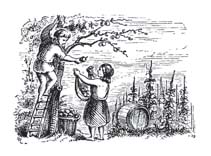Folklore of Lincolnshire (6 page)
Read Folklore of Lincolnshire Online
Authors: Susanna O'Neill

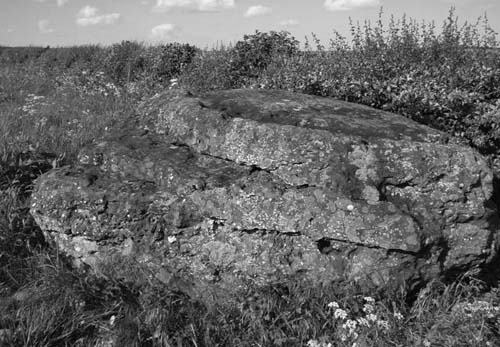
The Winceby Slash Stone, at the side of the road along Slash Lane, the B1195, between Horncastle and Spilsby.
The tale of the dragon of Castle Carlton, near Louth, is considerably more detailed than the Anwick tale, with no confusion as to what the beast was. The story runs that one Sir Hugh Barde, in the first year he came into the baronetcy, fought the dragon of Castle Carlton, whose people were being terrorised by a ‘dragon in a lane in the field that venomed men and bestes with his aire’.
19
Marlow describes it as a mighty beast, with a ‘long scaly body, short iron-shod legs, lashing tail, and head, in which was set one blazing eye the size of a basin’.
20
It was the terror of the countryside, causing chaos and devastation, devouring anyone it could get its teeth into. Its very breath was poison and even more deadly than the flames it exhaled. The scaly hide was so thick it seemed impenetrable and the people despaired, believing that they would never be able to overcome it.
The beast had one spot, however, that was vulnerable; a protruding wart on its right thigh that, if pierced, would kill the dragon outright. It guarded this area well and it seemed the beast never slept and so could not be caught off guard.
The idea of a dragon having a vulnerable spot is a common theme in dragon lore. Ralph Whitlock is something of a dragon expert and likens the Castle Carlton dragon to the Wantley dragon, which had a vulnerable place in the middle of its back and a dragon at Newcastle whose vulnerable spot was its navel.
Sir Hugh made a pledge to the people that he would slay the Castle Carlton dragon whatever it took, and would take its head to the king. He chose a wedding day, which portended good luck and set out with his sword and shield to hunt the beast down. He found it resting on the beach, after a hearty dinner of seven servants from the castle. Although it seemed asleep, ‘the cunning creature’s eye was ever vigilant. The dragon lay quietly but alert, waiting for its moment to strike.’
21
The brave knight suddenly cried out to St Bartholomew and St Guthlac to aid him in his quest, and as he was praying he heard an answer surround him, a booming voice, which told him, ‘Look for the bright light from heaven which shall blind the dragon – in the instant that light shines, strike hard or thou must perish’.
At this the dragon rose from its slumber, spreading its wings and flying straight towards its prey with the swiftness of a falcon. At that very moment the sky turned black and a sudden downpour descended in a torrent between Sir Hugh and the dragon. There was a tremendous rumble as thunder shook the sky and then a sudden blinding flash of lightning split the air, illuminating the dragon in all its terrible glory – shining directly upon the exposed wart. Sir Hugh took his opportunity and lifted his great sword, striking down with all his might to cleave the vulnerable mark. The mighty monster’s screech was equal to that of the thunderous storm raging all around them and it was so enraged that it sought to kill Sir Hugh with a vengeance. The saints were still helping him, however, and the dragon became lost and disorientated in the thick clouds billowing around them. All the while its life force was draining away, bleeding out of the fatal wound in its thigh. Eventually the beast dropped onto the sand, defeated, and the clouds cleared to show the prostrate form of the dead dragon lying at Sir Hugh’s feet. With one deft stroke, he sliced the head off and carried it back to the village to
announce his victory. The people rejoiced at their freedom from that mighty terror and Sir Hugh became a hero.
As promised, he took the dragon’s head to King Henry I. The king changed Hugh’s name to Bardolph and as Castle Carlton was the head of the baronetcy, he granted it many privileges, such as freedom from all tolls for Sir Hugh’s tenants and the right to take a horn of salt from every salt cart passing through his domain. Sir Hugh did not forget the help he had been given and made a pilgrimage to the saints’ shrine to lay down treasures and thanks. His deed was talked of widely, as was his bravery and the privileges he bestowed upon his people.
The
Lincolnshire Magazine
states that it was ‘this same valiant knight [who] had lands in Norfolk, his chief seat there being Wormgay, which name again retains the “dragon” tradition’.
Perhaps he and his ancestors were old hands at confronting dragons. It seems the baron’s crest included the image of a dragon’s head, but when researching Wormgay, the village’s name seems to stem from a family or the followers of a man called Wyrma. I can find no dragon legend attached to the area. Adrian Gray
22
suggests the Castle Carlton dragon may have lived at Walmsgate, near Louth, but that it was then known as Wormsegay. There is a long barrow at Walmsgate, which legend states holds the skeleton of a dragon that was slain in the area. If it is headless, then perhaps we would find our answer.
Whitlock quotes from a very early source, William Camden, writing in 1586:
Sir Hugh Bardolfe lived in Castle Carlton in the time of Henry I. It is said in a very old court roll that in the first year that Sir Hugh was lord of the place ther reigned at a toune called Wormesgay a dragon in a lane in a field that venomed men and bestes with his aire; Sir Hugh on a weddings day did fight with thys dragon and slew him, and toke his head, and beare it to the kynge and gave it him, and the kynge for slaying of the dragon put to his name this word dolfe, and did calle him afterwards Bardolfe; for it was before Sir Hugh Barde; and the kynge gave hym in his armes then a dragon in sygne.
23
In old Germanic
dolph
means ‘famous wolf’ – which could be a champion’s title given for bravery. Whitlock also proposes that Walmsgate may have originally been named Wormsgate.
Folklorists Gutch and Peacock refer to ‘a tradition, which probably took its rise at an early period, [which] tells of a huge serpent that devastated the village of South Ormsby and was slain at the adjacent hamlet of Walmsgate.’
24
This could be either another version of the slaying of the dragon and its burial in the barrow, or the tale of a different dragon, making the area rather unlucky in this respect! One version does suggest that there were actually three dragons in the area; one buried in the barrow, one flying away to settle in Dragon’s Hole in Corringham Scroggs, and the third fatally wounded, crawling away to die at Ormsby.
Gutch and Peacock state that
ormr
was the old Norse form of Anglo-Saxon
wyrm
, and in dragon tradition worm was another name for dragon, just like drake.
In many stories of dragons they are depicted as worm-like creatures, with no wings – like the famous Lambton Worm, a legend from the North East of England. South Ormsby, therefore, was apparently named after the dragon incident, as was, we assume, Walmsgate.
The worm-like dragons have also been depicted as serpents – and through much of history they have been linked with water: ‘On that day the Lord with his cruel and great and strong sword will punish Leviathan the fleeing serpent, Leviathan the twisting serpent; and he will kill the dragon that is in the sea.’
25
In fact, it is said the English word dragon derives from the Greek
drakon
, meaning serpent of huge size/water snake.
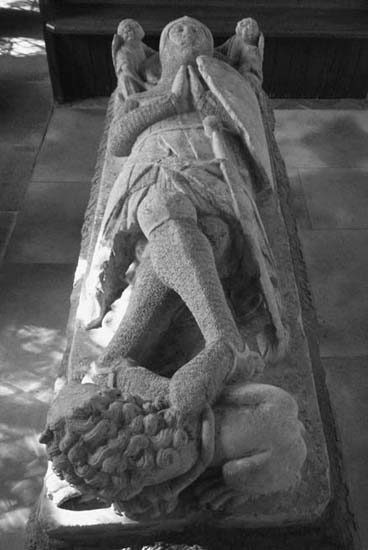
The effigy of Sir Buslingthorpe inside the small church, aptly named St Michael’s, at Buslingthorpe. The church is one of the few remaining buildings on the site of a deserted medieval village. The tower is all that survives from medieval times, the rest having being rebuilt in 1835, but the whole structure overlies the buried remains of a much older church.
There is another tale of a defeated dragon in Lincolnshire, at Buslingthorpe, near Lincoln. The famous dragon-slayer in this instance was Sir Buslingthorpe, who died around 1250. An effigy of this knight is housed in the little church of Buslingthorpe, St Michael’s. He was thought to have attacked the ferocious dragon and killed it and for such bravery and prowess, Sir John was awarded 400 acres of local land, known as Lissington Pasture.
The
Lincolnshire Magazine
suggests that he actually drained and reclaimed this marshy land, making it habitable, and this was how his fame arose. The fact that boggy, watery land was involved, however, seems to agree with the alleged link to serpents and worm-like dragons.
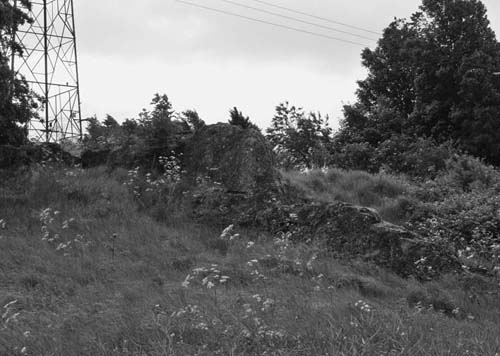
The head of the dragon-shaped rock residing on the hillside in the small village of Dragonby. Halfway down the road through the village there is a gap in the houses on the right-hand side. A track leads onto some open ground and the dragon can be clearly seen winding its way down the hill on the right, as if heading to drink from the pond at the bottom.
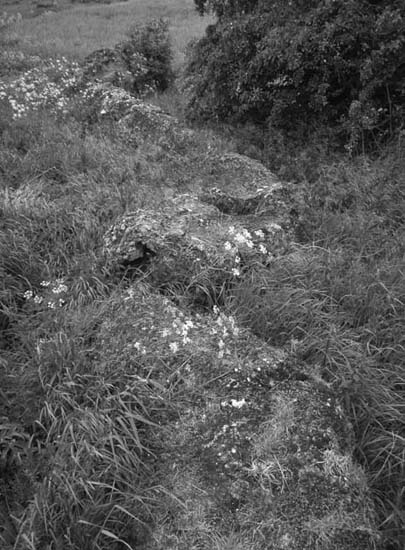
Part of the tail of the colossal stone dragon at Dragonby.
The other dragon we briefly touched on earlier was the creature that lived at Dragonby. The legend states this beast was the guardian of some mines but was defeated by a wizard, who turned it to stone – hence the ninety foot dragon-shaped rock that can be seen snaking its way up the hillside. It is actually a natural rock formation, apparently caused by a limestone spring, but legends often attach themselves to such wonders of nature. This particular rock has another myth attached to it, one concerning the Devil. The tale states that the ‘dragon’ rock is in fact the top of a church that once stood there but sank into the ground, congregation and all – and once a year the ghostly bells can still be heard to ring. The Devil had been attracted to the village because, as Daniel Codd tells us, ‘The community had fallen into avaricious ways.’
26
He caused the church to sink and sat on the roof, laughing all the while. When the congregation tried to leave they found themselves in a long, underground tunnel which led only down, to Hell!
T
HE
W
ET
AND
W
ILDS
